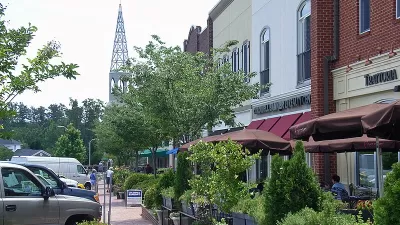How one master-planned development used lower-density urbanism principles to build a community focused on affordability, sustainability, and conservation.

In a long read in Common Edge, Steve Mouzon defends the utility of lower-density zoning and New Urbanist principles that may be more appropriate in certain settings, including places already slated for sprawl, with existing sprawl, or growing small towns.
The best vehicle for implementing principles illustrated here at the scale of a neighborhood, hamlet, or village is not a major production builder, as these principles violate almost all of their conventional industrial practices. Instead, look to the record of stronger New Urbanist developers who are no strangers to doing things considered unconventional by the Industrial Development Complex in the interest of better places with stronger lifetime returns.
Mouzon outlines his four principles for accomplishing lower-density urbanism in suburban and small town settings. These include compact development that allows for preservation of open space, “listening to the land,” creating a range of housing values, and bringing in a mix of uses.
Mouzon uses the example of a community called the Waters, a project he worked on near Montgomery, Alabama, describing how conscious design decisions helped the development reduce needed infrastructure, conserve more open space and preserve the character of the site, create opportunities for social interaction through front-facing porches and walkable spaces, and raise property values. The article offers an in-depth and instructive look at how a from-scratch planned development can use design principles to limit sprawl and conserve open space.
FULL STORY: What’s the Point of Lower-Density Urbanism?

Maui's Vacation Rental Debate Turns Ugly
Verbal attacks, misinformation campaigns and fistfights plague a high-stakes debate to convert thousands of vacation rentals into long-term housing.

Planetizen Federal Action Tracker
A weekly monitor of how Trump’s orders and actions are impacting planners and planning in America.

San Francisco Suspends Traffic Calming Amidst Record Deaths
Citing “a challenging fiscal landscape,” the city will cease the program on the heels of 42 traffic deaths, including 24 pedestrians.

Defunct Pittsburgh Power Plant to Become Residential Tower
A decommissioned steam heat plant will be redeveloped into almost 100 affordable housing units.

Trump Prompts Restructuring of Transportation Research Board in “Unprecedented Overreach”
The TRB has eliminated more than half of its committees including those focused on climate, equity, and cities.

Amtrak Rolls Out New Orleans to Alabama “Mardi Gras” Train
The new service will operate morning and evening departures between Mobile and New Orleans.
Urban Design for Planners 1: Software Tools
This six-course series explores essential urban design concepts using open source software and equips planners with the tools they need to participate fully in the urban design process.
Planning for Universal Design
Learn the tools for implementing Universal Design in planning regulations.
Heyer Gruel & Associates PA
JM Goldson LLC
Custer County Colorado
City of Camden Redevelopment Agency
City of Astoria
Transportation Research & Education Center (TREC) at Portland State University
Jefferson Parish Government
Camden Redevelopment Agency
City of Claremont





























